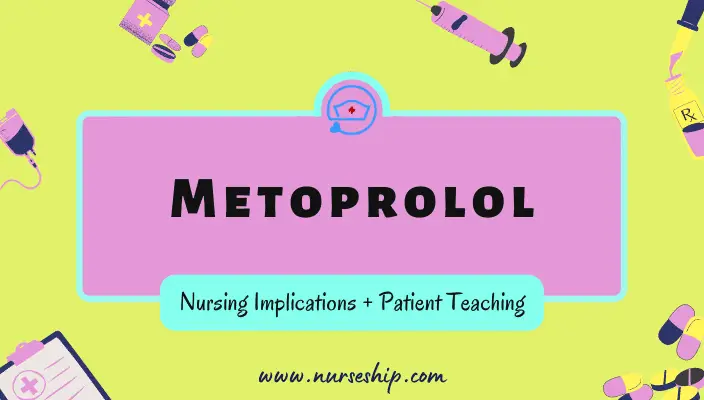Introduction
In this article, you’ll learn about metoprolol nursing implications and nurse teachings. Also, its dosage, indication, side effects. Nursing implications include nursing assessment, nursing interventions, nursing diagnoses, and evaluation for metoprolol.
Metoprolol is a beta-adrenergic blocker that is commonly prescribed as an antihypertensive medication. It is also used for angina and dysrhythmias.
Beta-blockers come in a variety of forms. Among them metoprolol is a cardioselective beta-blocker that works primarily on the β1 receptors rather than the β2 receptors, resulting in reduced bronchoconstriction.
Metoprolol tartrate vs Metoprolol succinate
Metoprolol comes in two salt forms known as metoprolol tartrate and metoprolol succinate.
The difference between both is that metoprolol tartrate is exclusively available as an immediate-release tablet, whereas metoprolol succinate is an extended-release tablet.
Generic Name: Metoprolol
Brand Names: Betaloc, Lopressor, Kaspargo, Toprol XL
Metoprolol Class and Category
Pharmacologic class: Beta1-adrenergic blocker
Therapeutic class: Antianginal, Antihypertensive
Pregnancy Category: C; (D during the second and third trimester)
Metoprolol Dosage
1. To manage hypertension
Extended-release (PO)
- Adults: 25- 100 mg/day. Maximum: 400 mg/day.
- Children 6 years and older: Initial dose: 1 mg/kg/day (initial dose should not to exceed 50 mg/day). Maximum: 2 mg/kg/ day (200mg/day)
Tablets (PO)
- Adults: Initial dose: 100 mg/day, OD or BD. Maximum dose: 450 mg/day, OD or BD.
- Children aged 6 and older: 1-2 mg/kg/day, BD. Maximum dose: 6 mg/kg/day or 200 mg/day
2. To treat acute MI
Adults:
- Initially 5 mg IV bolus every 2 minutes for 3 doses;
- Then, after 15 minutes of the final IV dose, 25-50 mg, PO, QID for 48 hours;
- Finally, 100 mg PO, BD, for at least 3 months.
3. To treat angina pectoris and chronic stable angina
Extended release (PO)
- Adults: 100 mg, BD. Maximum dose: 400 mg/day.
Tablets (PO)
- Adults: 50 mg BD. Maximum dose: 400 mg/day.
Metoprolol Pharmacokinetics and Pharmacodynamics
| Route | Onset | Peak | Duration |
| PO (immediate-release) | 10-15min | 1-2 hours | 10-19 hours |
| PO (extended-release) | (Unknown) | 6-12 hours | 24 hours |
| IV | Immediate | 20min | 4-10 hours |
Absorption: Metoprolol is effectively absorbed from the gastrointestinal tract when taken orally.
Distribution: Protein bounding is 10-12 %
Metabolism: Hepatic
Half-life: 3-7 hours
Excretion: Mostly the kidneys eliminate inactive substances through urine.
Metoprolol Mechanism of Action
Reduces cardiac output and myocardial oxygen demand by activating beta-receptor sites, which are mostly found in the heart.
These effects aid in the relief of angina, the reduction of cardiac tissue damage caused by myocardial infarction, and the reduction of heart failure symptoms.
Metoprolol also lowers blood pressure by inhibiting renin release in the kidneys. It has a negative chronotropic impact.
What are the indications of metoprolol?
Metoprolol indications include:
- To treat mild to moderate hypertension.
- To treat acute MI.
- To relieve angina pectoris.
- To treat heart failure and cardiomyopathy.
- Off-label uses include migraine prevention, heart rate control for atrial fibrillation and atrial flutter without accessory pathway, essential tremor, unstable angina.
What are the contraindications of metoprolol?
The contraindications of metoprolol are:
- Hypersensitivity to metoprolol.
- Hypersensitivity to metronidazole.
- Pregnancy (first trimester with trichomoniasis).
- Use of disulfiram within 2 weeks.
- Use of alcohol during therapy.
- Cardiogenic shock.
- Atrioventricular block (2nd and 3rd degree).
- Severe bradycardia.
- Systolic blood pressure less than 100 mmHg.
Caution:
Thyroid dysfunction, severe hepatic dysfunction, end-stage renal disease, PVD, DM, pregnancy, breastfeeding, geriatric patients, major surgery, COPD, CAD, sick sinus syndrome (SSS), bronchial asthma, CVA, children, depression, vasospastic angina, pheochromocytoma, seizure disorder.
Metoprolol Interactions
- Metoprolol plasma level raises when taken with antidepressants, antifungals, antihistamines, antimalarials, and antipsychotics. Which results in reduction in metoprolol cardioselectivity.
- Hypotensive effect of metoprolol is increased when administered with antihypertensives, alcohol, and anesthetics.
- Metoprolol’s antihypertensive effect is decreased when taken with salicylates and NSAIDs.
- Metoprolol has a vasoconstrictive effect with ergot alkaloids.
- Raise metoprolol levels with hydralazine.
- Metoprolol increases the effect of benzodiazepine.
- Metoprolol decreases the effects of xanthine, theophylline, and dopamine
- Reduces serum metoprolol levels with barbiturates.
- Digoxin and other beta blockers delay atrioventricular conduction and lower heart rate.
- Metoprolol increases liver enzymes, serum antinuclear antibody titer (ANA), serum BUN, uric acid, lipoprotein, LDH, blood glucose.
Herbal/food interactions
Herbs vary the effect of metoprolol in accordance with their properties.
The following herbals have hypertensive properties.
- licorice
- yohimbe
The following herbals have hypotensive properties.
- garlic
- ginger
- ginkgo biloba
What are metoprolol side effects?
Metoprolol side effects / adverse reactions include:
- Insomnia
- Drowsiness
- Fatigue or weakness
- Impotence and decreased libido
- Hypotension
- Bradycardia
- Blurred vision
- Nausea
- Vomiting
- Diarrhea/constipation
- Hepatitis
- Urinary frequency
- Purpura
- Urticaria
- Pruritus
- Life-threatening adverse effects: bronchospasm, complete heart block, cardiac arrest, agranulocytosis.
| Black Box Warning! |
| Withdrawing abruptly can result in MI, cardiac dysrhythmias, and myocardial ischemia. Dosage should be tapered over 7-14 days. |
Metoprolol Nursing Implications [Nursing Considerations]
Metoprolol nursing implications are divided into nursing assessment interventions and evaluation.
Metoprolol nursing assessment
- Obtain complete medical and herbal history from patient. Report to the prescriber if drug-to-drug or drug-to-herbal interaction is probable.
- Monitor blood pressure and apical pulse rate be administering metoprolol. Withhold the dose if systolic BP is less than 90 mmHg and pulse rate is less than 60 bpm and notify physician.
- Assess the anginal pain (severity, radiation, onset, duration, location, alleviating or aggravating factors, type)
- Obtain a baseline renal function test (RFT) and liver function test (LFT).
Metoprolol nursing diagnosis
- Decreased cardiac output (indication)
- Decreased cardiac tissue perfusion (indication)
- Acute pain (indication)
- Fatigue related to drug’s adverse effects
- Deficient knowledge related to disease process; drug’s mechanism of action and adverse effects
Nursing interventions/actions
- Monitor vital signs. Observe for hypotension, shortness of breath, and pulse’s rate, rhythm, and quality.
- Monitor ECG tracing during metoprolol’s IV administration and at the beginning of therapy. Because they are at risk of atrioventricular block.
- Closely observe for signs of heart failure such as dyspnea, nocturnal cough, peripheral edema, increased weight gain, and neck vein distention. Because beta-blockers like metoprolol reduce cardiac contractility.
- Monitor blood glucose levels in patient with DM. Because Metoprolol may alter with oral diabetics and insulin’s therapeutic effects.
- Maintain daily intake and output (I&O).
- Monitor LFTs, RFTs, and LDH.
- Monitor TFT for patients with hyperthyroidism. Because certain hyperthyroidism symptoms (such as tachycardia) may be obscured by beta-adrenergic blockers like metoprolol.
- Observe for signs of arterial insufficiency in patients with peripheral vascular disease (PVD) such as coldness, pain, and pallor in affected extremity. Because metoprolol can cause or worsen PVD.
- Closely monitor for bronchospasm and dyspnea in patients receiving more than 400mg/day. Because beta2-adrenergic receptors in bronchial and vascular smooth muscles are competitively inhibited by metoprolol.
IV administration considerations
- Administer undiluted metoprolol over I minute.
- Administer metoprolol infusion in 50 mL D5W or 0.9% NaCl over 30-60 minutes.
- Monitor ECG tracing and blood pressure during IV administration.
- Double-check the dose with another person to avoid possibly fatal mistakes.
- Store injection metoprolol in room temperature.
Evaluation
Evaluate the effectiveness of the drug: for reduced blood pressure; for alleviation of anginal pain; adherence to the treatment regimen.
Pregnancy/breastfeeding considerations for metoprolol
- Metoprolol’s effect on fetus is unknown.
- Consult the doctor before starting lactation.
Nursing patient teaching for metoprolol
The metoprolol’s nurse teaching for patients should include the following points.
- Teach the patient how to take pulse and blood pressure and to report abnormally high or low readings to the prescriber.
- Instruct the patient not to abruptly discontinue taking metoprolol. Because it may worsen HTN and may cause some adverse effects. It may also cause thyroid storm (thyrotoxic crisis) in patients with hyperthyroidism.
- Advise the patient to take metoprolol with meals at the same time every day to increase adherence.
- Explain the patient that if he/she is unable to swallow E.R capsule as a whole, he/she may put its content on soft food and consume it within 1 hour. Also, extended release tablets may cut but not to crush or chew.
- Advice the patient not to take double dose, if the dose is missed instead take the next scheduled dose.
- Instruct the patient to slowly transition from lying to sitting and sitting to standing. Sudden movements can cause orthostatic hypotension.
- Advice patient not to take OTC medicine such as nasal decongestants and cold drugs without consulting the prescriber.
- Advise the patient to eat a low-sodium diet and to cease smoking and drinking alcohol.
- Explain the patient about the importance of weight management, exercise, dietary changes, and adherence to treatment regimen to control high blood pressure and associated complications.
- Teach the patient signs of worsening heart failure such as breathing difficulty when lying down, abnormal cough at night, swelling of the extremities, weight gain.
- Educate diabetic patients about metoprolol’s effect on blood glucose and to closely monitor blood glucose and to report hypoglycemic symptoms such as palpitations, tachycardia, and tremors to the prescriber.
- Teach the patient about the adverse effects of metoprolol (such as bradycardia, dizziness, extreme fatigue, disorientation, depression, fever, sore throat, SOB, impaired vision) and to immediately notify them to the prescriber.
- Inform the patient that it may take 1 – 2 weeks to see a notable BP reduction.
Treatment of Overdose
- Gastric lavage
- Symptomatic treatment. For example, bradycardia is treated with injection atropine, bronchospasm is treated with injection theophylline, oxygen therapy, hemodialysis.
Conclusion
You learned about metoprolol nursing implications (aka nursing considerations) and nurse teachings in this article.
In addition, you’ve learned about metoprolol’s mechanism of action, pharmacokinetics, dosage, indications, contraindications, side effects, nursing assessment, nursing interventions, and nursing diagnoses.
Recommended Readings & Reference
Kee, J., Hayes, E., & McCuistion, L. (2015). PHARMACOLOGY A Patient-Centered Nursing Process Approach (8th ed.). Elsevier Inc/Saunders.
Kizior, R., & Hodgson, K. (2021). SAUNDERS NURSING DRUG HANDBOOK 2021. Elsevier Inc.
Jones & Bartlett Learning. (2021). Nurse’s Drug Handbook (20th ed.). Jones & Bartlett Learning, LLC.
Skidmore-Roth, L. (2021). MOSBY’S 2021 NURSING DRUG REFERENCE (34th ed.). Elsevier Inc.




